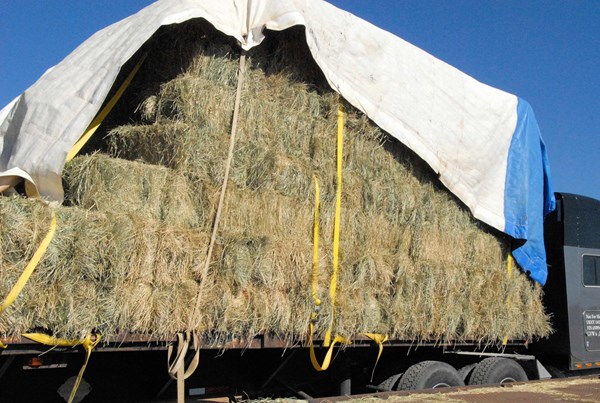 Credit: Charlene Strickland
Credit: Charlene StricklandOnce you have found good-quality hay for your horses, the next step is to store it so it remains good-quality hay. First you need to keep it dry to prevent mold. That means you have to protect the hay from moisture from above and below.
Ideally you have a spacious hay barn, well-roofed and possibly open on one side for access and ventilation. Any heat in the hay needs to escape; hay baled with too much moisture can become hot and even cause fires. The barn should be roomy so that it’s easy to stack bales.
Some barns are open on all sides for air circulation. While this can be good in climates that aren’t moist, understand that the ends of hay bales will bleach in sunlight and be subjected to blowing rain, sleet or snow.
A question many horse owners ask is whether they should have all of the winter’s hay supply delivered at once? That would depend on your storage capacity and cost. It might be cheaper to lose a few bales to weather and have it all delivered at once. However, if possible, have the hay delivered so you have a constant supply of quality hay that fits in your hay storage area. Keep in mind that your hay supplier probably has a larger hay barn, so it might be possible for you to arrange for him to store and deliver throughout the year.
Keep in mind that you need to keep ample hay on hand in case of bad weather when the hay supplier might not be able to get a heavy truck into your property.
Dr. S. Ray Smith, University of Kentucky State Forage Extension Specialist, said, “Many hay growers will keep it in their barn as long as they know you’ll be getting it, so you don’t need a big storage area.”
If you’re really limited on space, you can deal with a local feed store to buy smaller quantities. That will be more expensive in the long run, but will save you from ruining hay because of weather-related losses.
Helen Newton, who hauls reiners form Santa Fe, New Mexico, explained, “We have a small barn here in Santa Fe and currently do not have the capacity to store large quantities of hay. We purchase our hay (2-wire alfalfa) from a reliable provider (San Marcos Feed Store, south of Santa Fe) and are confident that we have good-quality hay. We do not use square bales, round bales or 3-wire bales because of the difficulty we have handling the product.”
Without a barn, you can adapt a large storage shed or cargo container. If you have to store hay outdoors, protect stacked hay with secured tarps or a plastic covering. Raise hay off bare ground using wood pallets or tires, or by building a pad of rocks or gravel. Take weather-ruined or moldy hay and put it off to the side. Offer it to a local cattle farmer who will pick it up so you don’t have to dispose of it.
Make sure to store hay away from your horse barn and any fire source. Warn smokers to keep away from your hay.
One problem with large hay stacks, whether inside or outside, is they can become unstable and fall, causing injury or even death. Stack hay bales safely, in a stable mass that’s not too high. You and your employees should be able to remove bales easily without encountering a hay bale avalanche.
Rodents are likely to live in stacked hay, and you might encounter lizards and snakes. Barn cats are the best defense against these pests.
Knowing you’re set with a supply of good-quality hay for several months relieves stress. When you see your supply neatly stacked, you feel satisfied that your barn’s good to go for winter.
Save


